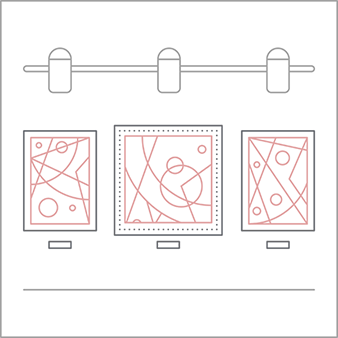You HavenÔÇÖt Started Wondering About Yet...
In the world of Roald Dahl childrenÔÇÖs imaginations save them from trouble, create worlds of wonder, find alternative meaning in the mundane, and transform ordinary life around them. Through this lens begins this exhibition.
Each of the artists create works that open a space for the viewer to translate their own interpretation and finish the storyline. Often balancing on the line between figuration and abstraction, the final reading of a piece is at the whim of those that view them. In James and the Giant Peach, the peach in JamesÔÇÖ backyard grows and becomes his means for escape, shelter and conduit to a new life. Art has the ability to allow these same transformations.
In the work of Bernhard Buhmann and Tracy Thomason abstract compositions move between references to bodily movement and mechanical instruction. Elements of each artistÔÇÖs paintings defy singular definition or identification.
Justin Fitzpatrick, Emily Furr, Kristina Lee and Dana Lok play with the surreal and alter the representation of physical objects to give them multifunctional identities. In FitzpatrickÔÇÖs work, the body of a bird becomes a cop car on a chase. LokÔÇÖs objects vacillate between futuristic machinery and abstract landscape. Furr turns the ordinary into the erotic, while LeeÔÇÖs biomorphic shapes push the boundaries of body and water.
Matthew Chambers, Ryan Wilde and Johannes VanDerBeekÔÇÖs works physically confront the viewer. Chambers rips apart former figurative paintings and sculpts them over stretcher bars to create minimally elegant wall works. Wilde similarly uses the wall to hang her felt and faux hair sculptures that allude to disembodied parts of the human form. While VanDerBeekÔÇÖs freestanding sculptures relate to the body in terms of scale, they are more symbolic and archaic in the way that they represent the figure.
Together the show examines the joy and magic that time with art can instill within us. The transformative powers that certain works bestow upon the viewer give clues about intention but never reveal the entire story.

Recommended for you
In the world of Roald Dahl childrenÔÇÖs imaginations save them from trouble, create worlds of wonder, find alternative meaning in the mundane, and transform ordinary life around them. Through this lens begins this exhibition.
Each of the artists create works that open a space for the viewer to translate their own interpretation and finish the storyline. Often balancing on the line between figuration and abstraction, the final reading of a piece is at the whim of those that view them. In James and the Giant Peach, the peach in JamesÔÇÖ backyard grows and becomes his means for escape, shelter and conduit to a new life. Art has the ability to allow these same transformations.
In the work of Bernhard Buhmann and Tracy Thomason abstract compositions move between references to bodily movement and mechanical instruction. Elements of each artistÔÇÖs paintings defy singular definition or identification.
Justin Fitzpatrick, Emily Furr, Kristina Lee and Dana Lok play with the surreal and alter the representation of physical objects to give them multifunctional identities. In FitzpatrickÔÇÖs work, the body of a bird becomes a cop car on a chase. LokÔÇÖs objects vacillate between futuristic machinery and abstract landscape. Furr turns the ordinary into the erotic, while LeeÔÇÖs biomorphic shapes push the boundaries of body and water.
Matthew Chambers, Ryan Wilde and Johannes VanDerBeekÔÇÖs works physically confront the viewer. Chambers rips apart former figurative paintings and sculpts them over stretcher bars to create minimally elegant wall works. Wilde similarly uses the wall to hang her felt and faux hair sculptures that allude to disembodied parts of the human form. While VanDerBeekÔÇÖs freestanding sculptures relate to the body in terms of scale, they are more symbolic and archaic in the way that they represent the figure.
Together the show examines the joy and magic that time with art can instill within us. The transformative powers that certain works bestow upon the viewer give clues about intention but never reveal the entire story.















